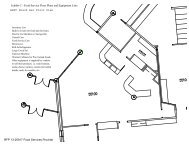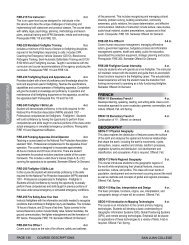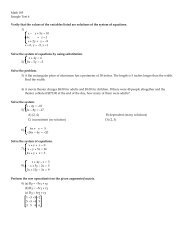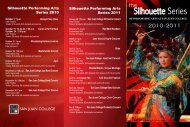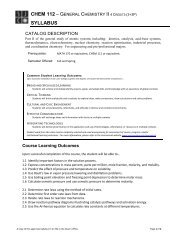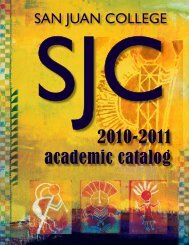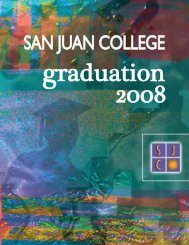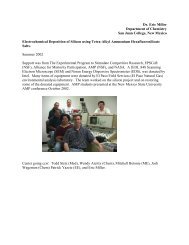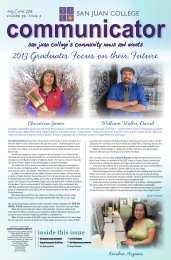<strong>San</strong> <strong>Juan</strong> <strong>College</strong> – <strong>AQIP</strong> <strong>Systems</strong> <strong>Portfolio</strong> – November <strong>2007</strong>PartnershipDevelopmentProcessEnvironmentalScanContinuousImprovementsViableCollaborativeRelationshipsDefineBoundariesAssessGreatest NeedsFigure 9.1 Partnership Development Processprocess evaluates needs and priorities, aligningpartnership development with strategic goals.Since finances and/or time do not allow for allcollaborative relationships to be carried out,desired partnerships are determined during theplanning process.• Define Boundaries of Collaborative RelationshipsWhen it is determined that a collaborativerelationship will be created, the timeline isdeveloped, fund allocation and personnelresearched, and the expected outcomes aredelineated. Campus representative invitecommunity members to an organizationalmeeting where the partnership is defined,boundaries and objectives communicated, andpartnership established.• Making Continuous Improvements As thecollaborative relationship moves forward, thedesignated liaison/champion, as well as othercollege administration and staff, reviews theeffectiveness of the partnership and refines areasthat need to be addressed.<strong>San</strong> <strong>Juan</strong> <strong>College</strong> has determined that it is difficult tostandardize a process for creating, prioritizing andmaintaining these partnerships as no twocollaborative relationships are the same. However, itis still in the best interest of the <strong>College</strong> to supportadministration and staff by providing an infrastructureconducive to partnerships9P2 <strong>San</strong> <strong>Juan</strong> <strong>College</strong> carries out both formal andinformal communication with partners in order toensure the varying needs of the collaborativerelationships are being met. These methods include:• Most programming and training has a formalevaluation built into the development andimplementation process. These evaluations arecarefully monitored and responded to by adaptingofferings accordingly when possible.• The more than 450 members of our advisorycouncils meet regularly and are often employeesof our collaborative partner entities. The collegereceives valuable feedback from them, andresponds to their needs and assessment ofcollege performance.• Evaluative analysis of partnerships is a part ofeach of our student internships, clinicals,practicums and placements. The <strong>College</strong>analyzes these collaborations formally andclosely so that partners are satisfied in the qualityof continued work.• Numerous times during the year, keycommunities of people are identified asstakeholders of various programs or of the<strong>College</strong> as a whole. These key communities areasked, through focus groups or surveys, todetermine if their needs and satisfaction arebeing met.• Informal feedback is obtained through ongoingdialogue with our partners. Collaborativerelationships are refined based on that dialogue,thereby balancing the needs of the relationshipand the college.SJC ensures the varying needs of each collaborativerelationship have been met through the formal and<strong>AQIP</strong> Category Nine: Building Collaborative Relationships 78
<strong>San</strong> <strong>Juan</strong> <strong>College</strong> – <strong>AQIP</strong> <strong>Systems</strong> <strong>Portfolio</strong> – November <strong>2007</strong>informal analysis of key stakeholder feedback. Duringthe partnership development, the college collectsformative assessments and adjusts the membershipand charge of the partnership as needed. Formaladvisory group input for curricular development isintegrated into the program design in annualimprovement cycles. The college liaison or championinforms the more formal college processes, andresponding change is supported in the collegeplanning process.9P3 <strong>San</strong> <strong>Juan</strong> <strong>College</strong> creates and builds numerousrelationships within its institution through crossfunctionalteams, councils or committees. This allowsfor important input across departments into decisionmaking,problem solving and communication.SJC has a highly participatory strategic planningprocess that increases communication and helpsbuild internal partnerships at the <strong>College</strong>. During thisprocess, all employees have the opportunity toprovide input to department plans, which are thenprioritized in creating each level of refinement in thefinal plan. This process is described further inCategory 8.In addition, two continuous quality improvementcouncils and five taskforces address research andconcerns in self-selected groups from all areas of the<strong>College</strong>. A Vice President serves as the Councilchampion and the President defines a focus for eachcouncil for the year. The President’s Cabinet,Recognition Team, Assessment Committee, andCurriculum Committee are other entities that serve asvehicles for creating and building workplacerelationships.The CTX provides a physical location as well asprogramming for all staff, to promote excellentteaching and learning, collaboration andcommunication. Activities draw participants from allemployee groups and across campus, allowinggreater understanding and incubation of partnershipsamong those of common interests. Reading groups,professional learning communities, and regularpresentations promote these cross-functional groupsto learn and develop ideas for problem solution.9P4 The <strong>College</strong> collects and analyzes numerousmeasures that reflect the building of collaborativerelationships. Those measures include data such as:• Number for key performance indicators asmeasured for the New Mexico Higher EducationDepartment.• Number and scope of articulation agreements.• Number of local high school students who attendSJC upon graduating.• Number of SJC students participating inpracticums, apprenticeships, internships and jobplacements.• Overall institutional attitudes based on building ofinternal and external collaborative relationshipsas measured on the PACE survey.• Satisfaction level and suggestions forimprovement collected from advisory councilmembers• Community support of bond issues.• Number of participants in non-credit events suchas the Bus Institute, astronomy programming,science and career fairs, etc.• Number of attendees using SJC facilities formeetings.• Milestones of performance as measured by theNew Mexico Small Business DevelopmentCenter.• Number of participants being sent frombusinesses to receive non-credit trainingexperiences.Results (R)9R1 The <strong>College</strong> has analyzed the key collaborativerelationships through the Quality Community LinkagesCouncil, assessing the essential links to programs.Each partnership category was identified and rated asa major link, regular link, occasional link or no link.The college learned it had many obsolete orineffective collaborations, as well as strong andeffective, active partnerships. A matrix of thecollaborations revealed the most important links toaddress for each program, and a survey revealed aneed to strengthen some of them. An example portionof the matrix is given below (Table 9.2).The Quality Community Linkages Council followedthis analysis with a survey and addressed a need tostrengthen program advisory boards with trainingdesigned for both the college liaison and advisoryboard members. An Advisory Board handbook wasdeveloped and disseminated to participants in thetraining. Follow-up assessment and feedbackrevealed the community members had a need forpartnership expectations and parameters, basicadvice on effective meetings, and desired recognitionfor their work.The college refined the Advisory Council handbookwith information learned in the series of trainings, andheld several recognition events for college liaisonsand advisory board members. Satisfaction in theprocess and events was expressed from both internaland external participants.In 2005, SJC contracted with Learning ResourcesNetwork (LERN) to conduct a review of the CLC andB & I Training, recommend structure, procedures,benchmarks and best practices SJC should follow togo forward and to train staff in the specific knowledge,skills and attitudes that will enable progress. LERNsent surveys to CLC students and instructors and B &I Training clients and instructors. Results arepresented in Table 9.3.<strong>AQIP</strong> Category Nine: Building Collaborative Relationships 79



